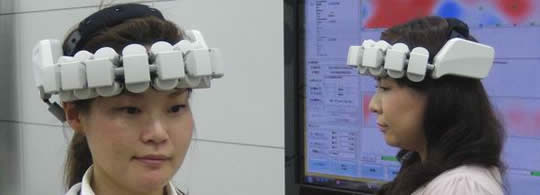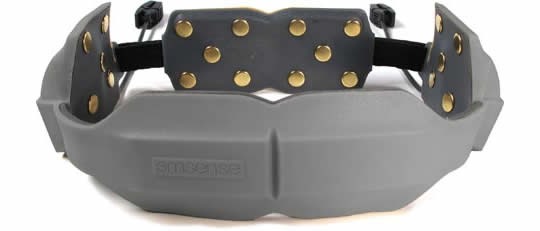New Neuromarketing Headsets
A couple of new headsets that can be used for neuromarketing studies won’t win any fashion awards, but offer the potential to gauge consumer reactions in relatively normal situations. The first is from Hitachi, and in contrast to the more common EEG caps it employs far-red light technology:
Because far-red light is directed at the forehead, the prefrontal area of a brain is monitored. By using multiple encephalometers, it is possible to measure the brain activities of four subjects at the same time.
The new encephalometer was developed based on the “optical topography method (NIRS: near infrared spectroscopy),” a brain monitoring method that Hitachi developed in 1995. Far-red light passes through a skull, etc and is scattered and reflected inside the brain. By measuring the degrees of the scattering and reflection, the encephalometer estimates the change in blood flow inside the brain. Specifically, it monitors hemoglobins. [From Tech-On – Hitachi to Launch Wearable Brain Analyzer.]
Hitachi’s encephalometer gets 2 hours of battery life and transmits data via wireless LAN, so mobility is excellent (except for the appearance issue, of course). To my knowledge, no commercial neuromarketing firm is using this type of technology. One wonders whether monitoring just the prefrontal area of the brain is sufficient for neuromarketing purposes. Of course, in the absence of published studies on the accuracy of predictions made with different types of brain activity measurement, the effectiveness of a device like this is open to conjecture.
The other recent addition to the neuromarketing measurement field is the Emband 24 from EmSense. The firm describes the new unit in a burst of trademarked jargon:
Using its Made for Purpose™ design, EmSense has employed several new proprietary technologies in the release of the new EmBand 24, including Sensor Fusion Processors™, Contact Clusters™ and Through the Hair EEG™. The headset is designed specifically for market research and overcomes many limitations of using medical EEG for market research. “Now marketers can have more extensive, robust measurements without trading off consumer comfort, quantitative samples or ease of use,” says Keith Winter, EmSense CEO.
EmSense proprietary sensors provide more targeted measurement with greater precision than medical sensors. The Contact Cluster technology enables the ability to take individual anatomical differences into account and give maximum spatial resolution in targeted regions. New Through the Hair EEG sensors allow non-obtrusive measurement without the need for unpleasant, messy gels that require respondent clean-up.
Using 24 EEG sensors, each measuring at 20,000 times per second, the headset collects 480,000 measurements per second. In addition, the EmBand 24 provides an unparalleled signal-to-noise ratio in real-world, in-context conditions. In keeping with the company’s non-invasive design philosophy, the EmBand 24 headset does not require caps, gels or wires and calibrates in only one minute. [From Emsense News Release.]
In his book The Singularity is Near, futurist Ray Kurzweil predicts exponential growth in the spatial and temporal resolution of brain scan technology. It’s hard to say if either of these devices moves us down that curve, but it’s good to see that people are attacking the problem from a variety of directions.


